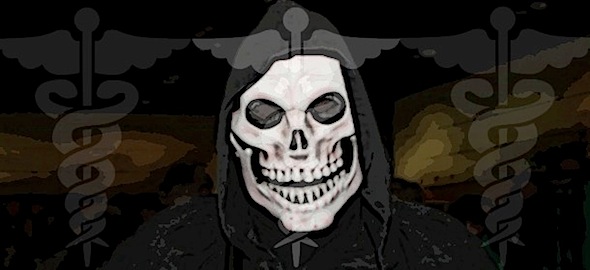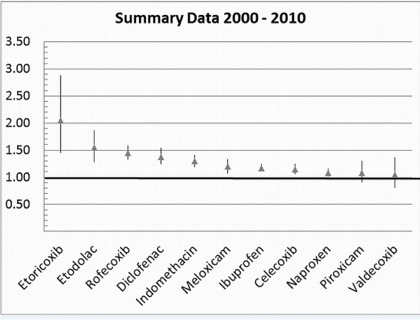Gaia Health
February 21, 2013
Diclofenac has long been known to be a killer, every bit as dangerous as Vioxx, which may have killed half a million people in the US alone. But diclofenac isn’t only a prescription drug. It’s sold over-the-counter. Yet doctors keep prescribing it and regulators do nothing to control or even warn about it.

Death Mask, Original photo by , cropped, filter and caduceus added
by Heidi Stevenson
Diclofenac is a very common over-the-counter NSAID (non-steroidal anti-inflammatory drug) that can kill at a significantly greater rate than most other NSAIDs. It may be even deadlier than the infamous Vioxx, which officially killed tens of thousands of people. The reality, as reported in Gaia Health, is frighteningly worse. It’s more likely that Vioxx killed half a million Americans.
But Vioxx was only available by prescription. Diclofenac is available both by prescription and casually in drug stores and supermarkets—any place where you might buy over-the-counter pain pills. It’s so profitable that the number of names under which it’s sold is stunning—well over a hundred. You’ve likely seen it as Anuva, Voltarol, Sandoz, or Voltral.
Gaia Health warned about Diclofenac in Diclofenac Deaths May Dwarf Vioxx Disaster: Health Agencies Helped It Happen. About a year-and-a-half ago, a PLoS article reported that heart attacks are 1.4 times more likely if patients take Diclofenac[1].
New Study
Now, we have new PLoS reports documenting and discussing the reality. The aforementioned study examines several existing studies to identify the relative risks of different NSAIDs[1]. They found that all NSAIDs studied increase the risk of heart attacks to some degree.

Etoricoxib increases the cardiovascular risk by more than double and etodolac increases the risk 1½ times. These are prescription-only drugs.
Much more worrisome, though, is diclofenac. Notice that result for rofecoxib, which is the generic name for Vioxx, is almost the same as that for diclofenac.
Now consider that diclofenac is being heavily pushed on people in pharmacies and supermarkets. It is a very popular over the counter drug. Therefore, it’s only reasonable to assume that diclofenac is killing far more people than Vioxx ever did—and Vioxx was pulled off the market for precisely this same risk!
The Evidence-Based Medicine Fraud
The PLoS study, “Use of Non-Steroidal Anti-Inflammatory Drugs That Elevate Cardiovascular Risk: An Examination of Sales and Essential Medicines Lists in Low-, Middle-, and High-Income Countries”, states the issue clearly:
NSAIDs with a high risk of cardiovascular complications are widely used. Diclofenac and etoricoxib together account for approximately one-third of all sales of NSAIDs in the countries included in our analysis. There was no difference between high- and low-income countries. Diclofenac was by far the most popular NSAID, despite having an RR [relative risk] identical to rofecoxib, which was withdrawn from world markets 8 years ago owing to cardiovascular toxicity. The information on cardiovascular risk associated with diclofenac has been available to regulators, writers of guidelines and essential medicines lists, and prescribers for at least 5 years. Calls have been made for its withdrawal. High levels of sales as recently as 2011 suggest that none of this information has resulted in effective action. There has been a slow decline in prescription numbers in England, Australia, and Canada since 2006, but it remains popular in all three countries, particularly in England where it is the single most-prescribed NSAID.[2] [Emphasis mine.]
Please read this statement carefully. It makes absolutely clear that, in spite of the risks being known for many years, little or no change has been made in prescriptions of diclofenac.
What’s all that we hear modern medicine so proudly proclaim? Their practice is based on evidence? You know the mantra of evidence-based medicine is based on scientific studies.
In fact, modern medicine is not generally based on science. It’s based on profits. Science is used primarily by Big Pharma—misused, in reality—to push its drugs on us by any means possible. Pseudo studies are produced that make false claims, both for efficacy and safety.
The same process is repeated again and again. A new drug comes on the market, coordinated with an expensive and effective marketing campaign that includes advertisements everywhere they’re legal—and in the US, that’s everywhere. Faux grassroots organizations are quickly put together and other patient groups jump on the bandwagon to lobby for rapid approval and dissemination of the drug. Doctors jump on the bandwagon almost immediately, dispensing samples and prescriptions to just about anyone who wants them.
In time, reports of the harms start coming out. Initially they’re termed “coincidental”. Big Pharma stands behind their products, using every tool at their deep pockets disposal deployed to keep the poison on the market as long as possible. Doctors hide behind the mantra of evidence-based medicine, claiming that the drugs have little risk—completely ignoring the fact that Big Pharma studies are often fraudulent, using games like non-publishing of negative results, twisting statistics, and making claims in their journal reports that aren’t supported by their data.
But the doctors hide behind the false glamour of evidence-based medicine and continue to prescribe. They deny their patients’ reports of adverse effects and lack of efficacy. And they fail even to pay attention to studies that point out the risks. As stated by K. Srinath Reddy and Ambuj Roy in PLoS:
[P]racticing physicians have a duty to regularly update their knowledge on the drugs they frequently prescribe. [3]
Clearly, the doctors are not paying attention.
Finally, as the public gradually becomes aware, as the bad publicity increases, a new drug comes along to replace the old one now known to be ineffective and dangerous. And the process starts all over again.
This is the state of modern medicine. As we see the truth about drug after drug and treatment after treatment reach the point where it can no longer be hidden, the reality of medicine’s claim to rely on evidence is proven utterly false.
Sources:
1. Cardiovascular Risk with Non-Steroidal Anti-Inflammatory Drugs: Systematic Review of Population-Based Controlled Observational Studies, PLoS, Patricia McGettigan, David Henry; doi:10.1371/journal.pmed.1001098
2. Use of Non-Steroidal Anti-Inflammatory Drugs That Elevate Cardiovascular Risk: An Examination of Sales and Essential Medicines Lists in Low-, Middle-, and High-Income Countries, PLoS, Patricia McGettigan, David Henry; doi:10.1371/journal.pmed.1001388
3. Cardiovascular Risk of NSAIDs: Time to Translate Knowledge into Practice, PLoS, K. Srinath Reddy and Ambuj Roy; doi:10.1371/journal.pmed.1001389






Leave a comment